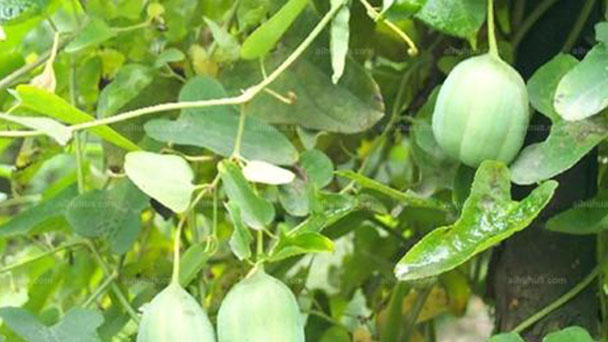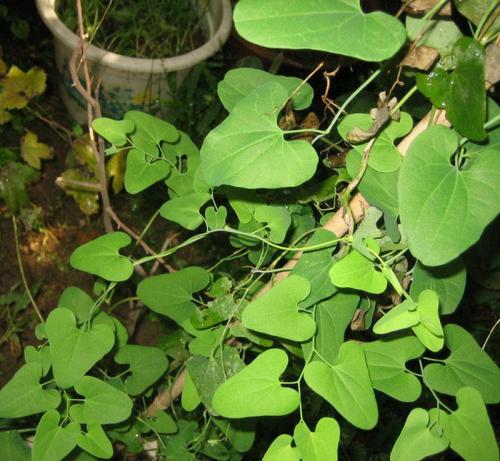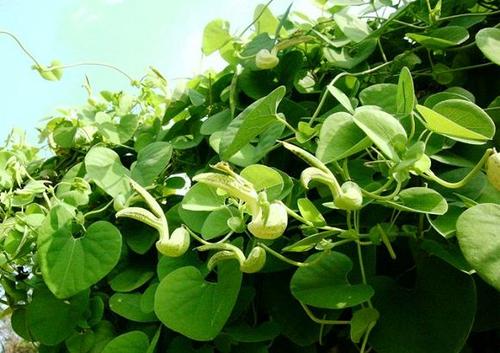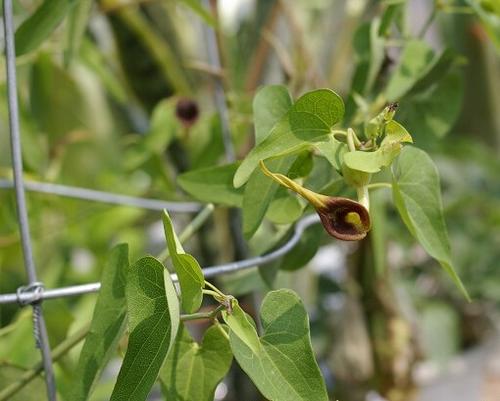Dutchmans pipe info: plant care & growing guide
Written by Maggie
Mar 18 2021

Dutchman's Pipe (Aristolochia debilis Sieb. Et Zucc) is a perennial twining herb. The root, stem and fruit are all called Dutchman's pipe. Dutchman's pipe has the functions of clearing lungs, relieving cough and asthma, clearing intestines and eliminating hemorrhoids.
Dutchman's pipe picture

Dutchman's pipe info
| Botanical Name | Aristolochia macrophylla |
| Common Names | Dutchman's pipe vine |
| Plant Type | Vine |
| Sun | Full sun, partial shade |
| Hardiness Zones | 4–8 (USDA) |
| Flower color | Yellow, green, purple |
| Native Area | North America |
| Mature size | 15–30 ft. tall, 15–20 ft. wide |
Morphological characteristics of Dutchman's pipe
Rhizome
Dutchman's Pipe is a grass vine. The root is cylindrical. Stem is weak, glabrous.
Leaf
Leaves of Dutchman's pipe alternate; Petiole is 1 -- 2cm long, delicate; Leaf blade is ovate-triangular, oblong-ovate or halberate, 3 -- 6cm long, base 1.5 -- 3.5cm wide, apex obtuse or shortly acuminate, base cordate, lobes rounded on both sides, pendulous or slightly extended; Dutchman's pipe has 5-7 basal veins, veins at all levels are obvious on both sides.
Flowers
Flowers of Dutchman's pipe solitary or 2-clustered in leaf axils; Pedicels are 1 -- 1, 5cm; Bracteoles are triangular, easily detached; The perianth is 3 -- 5.5cm long, the base is enlarged and spherical, the tube is narrowed upward into a long tube, the mouth of the tube is enlarged into a funnel-shaped, yellow-green, the mouth has purple spots, and the inner surface has glandular hairs; One side of the eave is very short, the other side gradually extends into the tongue;Ligule ovate-lanceolate, tip obtuse; Anthocyanin affixes are near the base of the pistil column; Atrium of Dutchman's pipe is cylindrical, 6-sided; Apex of monocystis is 6-lobed, slightly papillary, lobes obtuse, extending downward to form a undulate ring.
Fruit
Capsule of Dutchman's pipe is subglobose, apex rounded and slightly concave, 6-sided, descending from base upward along space at maturity; Fruit pedicels are 2.5 -- 5cm long, often torn into 6 strips. Seeds are flattened, obtuse triangular, margins with white membranous broad wings.
The ecological habits of Dutchman's pipe
Dutchman's Pipe is found in valleys, ditches, damp roadsides and thickets on hillsides at altitudes of 200-1500 meters. Dutchman's Pipe is light-loving, slightly shade tolerant, sandy yellow soil tolerant to cold.
How to grow and care for Dutchman's pipe
Scarification weeding
Seedling of Dutchman's pipe should be frequently soil weeding. Generally in the seedling height of 5 cm, plow weeding 1 times, appropriate shallow, to avoid root injury. After the combination of top dressing and weeding again 3 ~ 4 times, to prevent grass wastage.
Thinning and fixing seedlings
When the seedling height of Dutchman's pipe is 5 cm, the combination of soil loosening and weeding is carried out to thin the seedlings to remove the weak and keep the strong. When the seedling height is 10 centimeters, according to the plant spacing of 3 to 5 centimeters. Seedling 15 ~ 20 cm high, you can go out planting.
Fertilizer
In winter or early spring, the amount of nitrogen fertilizer should be controlled to avoid excessive growth of stems and leaves and damage from diseases and insects. Before flowers, the manure should be mainly applied and phosphorus fertilizer should be added appropriately. In the late growth period, 750 kg of superphosphate and 150 kg of potassium fertilizer were applied per hectare in summer, which could not only improve the fruit-setting rate, but also facilitate the growth of the root system, which was an important link in increasing yield.
Pruning and earthing
When the Dutchman's pipe enters vigorous growth in spring, cut off overgrown stems and tendrils without flower buds to reduce the consumption of nutrients. After the fruit is harvested in October, all the stems and tendrils are cut off, and weeds in the field are removed. Earth-raising and topdressing are carried out before winter for the benefit of heat preservation and winter overwinter, which lays a foundation for the next year's high yield.
Watering
Dutchman's Pipe is drought resistant and does not normally require watering.But when the growing period is too dry, want proper watering, rainy season wants timely drainage, lest rot root.

Disease control of Dutchman's Pipe
Root rot
The most common disease in summer, root rot, plant death.
Method of prevention and cure
Pulling out the diseased plant and burning it; Spray the acupoint with 1000 times of sterilized 50% wettable powder.
Leaf spot
More in the rainy season, leaf prone to spot. Pay attention to clean up the drain, remove the water in time, spray 1:1:150 times Bordeaux liquid.
The Dutchman 's wind pipe young moth
Young moth eats leaves, form a notch, and happen more in summer.
Method of prevention and cure
Clean the field, clean the garden in winter and deal with the residual plants.At young age, spray 50% phosphosamine 1500 times solution or cylinderum fungus (10 billion spores /g) 500 times solution.
Classification of varieties of Dutchman's pipe
North Dutchman 's pipe
It's a mainstream product of Dutchman's Pipe. Its characteristic is: is oval or long oval, the top is broader, the base is connected with a fine stalk. The surface is grayish green or grayish yellow, usually dehiscing from bottom to top along the ventral suture into six petals, the stalk also cleaved into lines. Seed majority, layers of flat superposition, four sides extend into opaque or translucent wings, flat triangular or fan-shaped, light brown edge.Brown in the center.Seed kernel milky white, oily. It has a slight breath and a bitter taste.
South Dutchman 's pipe
South Dutchman's Pipe is rare because of the saying, "Pick more fruit in the North and more roots in the South." The commodity Dutchman's Pipe has similar characteristics to the previous species, but the fruit is smaller and slightly round. The kernel is slightly heart-shaped.
Dutchman's pipe distribution
Dutchman's pipe is distributed in provinces south of the Yellow River to the south of the Yangtze River basin, Shandong (Mengshan), Henan (Funiu Mountain), etc. Guangdong, Guangxi often cultivated.
Dutchman's Pipe is also found in Japan.
Dutchman's pipe uses
Medical uses
Dutchman's Pipe has a mild and lasting antihypertensive effect. It is suitable for early hypertension preparations and its usage varies from place to place, and the efficacy varies slightly. Dutchman's pipe has obvious antitussive effect on the model of ammonium hydroxide spray induced cough
Landscape use of Dutchman's pipe
Dutchman's Pipe is found along country roads, in forest margins, and in thickets. In the garden, Dutchman's pipe should be planted in pieces, as ground cover plants, let it spread. It can also be used as vertical greening material for climbing low fences.
Dutchman's Pipe has been found to have serious carcinogenic effects and it is recommended that few or no plants be planted.

Latest Updated
- Benefits of Bugleweed - 7 Science-backed Health Benefits
- Bugleweed Dangers & Side Effects - Is It Poisonous?
- How to Plant Evergreen Trees - What You Should Know
- When to Plant Evergreens - Grow Guide for Evergreen Trees
- 12 Wonderful Evergreen Shrubs for Your Garden
- 12 Popular Evergreen Plants with Pictures for Beginners
- When And How To Prune A Lilac Bush Like a Pro
- How to Grow & Care for Lilac Vine (Hardenbergia Violacea)
- Japanese Lilac Tree (Syringa Reticulata) Care & Propagation Guide
- Shumard Oak Pros and Cons - What to Know
Popular Articles
- Winter maintenance of Antirrhinum Majus
- How to Grow Terminalia Mantaly Tree
- How to Grow and Care for Crossostephium Chinense
- How to grow Antirrhinum Majus in spring
- Peristeria Elata (Dove Orchid) Profile: Info & Care Guide
- Underwatered Snake Plant (Sansevieria Trifasciata) - Signs And How To Fix
- How to Care for Brazilian Jasmine Plant (Mandevilla Sanderi)
- How to Grow & Care for Graptopetalum Purple Delight in Summer
- Rosa Chinensis (China Rose): Plant Growing & Care Tips
- How to Care for Baby Sun Rose (Aptenia Cordifolia)